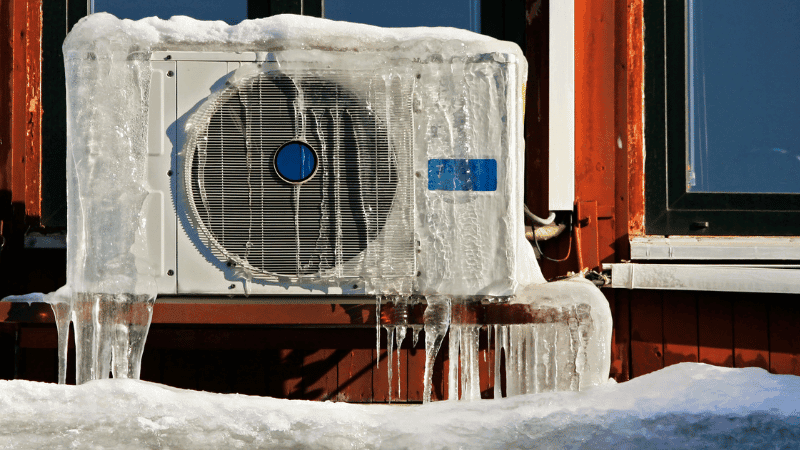How to prep your HVAC for winter storms

Oh, the weather outside is frightful, but the central heating system is so delightful!
With winter weather on its way, it’s essential to keep your heating system in top shape. We’ll provide tips on how to prep your HVAC for winter storms.
Do you have to remove snow from your HVAC unit?
If you’re worried about snow in your AC unit, don’t be. Manufacturers build air conditioning and heat pump condensers to withstand some snow.
We recommend clearing snow around the condenser if you rely on a heat pump to heat your home. Once it’s safe, dust snow off the top of the unit. Shovel at least 18 inches around the condenser on all sides to ensure proper airflow.
Some homeowners use snow legs to protect their heat pump in the winter. These risers should boost the unit above the typical average snowfall for your area.
We suggest a professional install snow legs on your heat pump before a winter storm. They can also protect your system if your area is prone to flooding.
How to protect your AC from snow
If you have a cooling-only AC system, snow in your outdoor unit is not a concern. Since you likely won’t use your AC in snowy conditions, leave it and let the snow and ice melt naturally.
Once the cooling season is over, turn your AC off for the winter. Locate the switch it’s attached to (usually on an external wall of your home), lift the protective cover, and turn it off. Switch your thermostat to “heat” and “auto.”
We do not recommend covering your AC condenser with a tarp or fabric cover for the winter, as they can create mold issues. A mesh-style cover may help to keep leaves out if your trees still have them.
If there’s excessive snow on top of it, you may wish to clean some off to prevent the condenser’s external covering from warping or bending.
If you use a window air conditioner, you should protect your AC unit from snow. Check out our guide on how to remove, clean, and store your window AC.
How to protect your HVAC from ice
If your outdoor condenser is exclusively for air conditioning, you don’t need to do anything to protect it from ice. Do not use your air conditioner when the temperature is below 60℉.
Heat pumps that heat and cool a home may enter defrost mode in icy conditions. This is a self-preserving function wherein the heat pump uses its warming power to melt the ice on its components to continue heating your home.
When a heat pump goes into defrost mode, it may stop providing heat to the house for a short time. You may choose to turn on its emergency heat setting at this time to keep warm. We suggest only doing so in an emergency, as it will burden your system and spike your utility bills.
If you use a window AC and can’t remove it from your window in the winter, consider protecting it with a water-resistant cover.
Heating your home in a power outage
You can take some preventative measures to keep your home comfortable when you anticipate losing power in a winter storm.
| 🌡️ Turn your thermostat up a few degrees, so your house will stay warm throughout the power outage. |
| 🔥 Choose one room as a designated “warm room.” Gather your family in there with blankets and mattresses for sleeping. |
| 🪟 Keep your warm room insulated by closing the window coverings and sealing cracks in the door. |
| 🔋 Consider purchasing a battery-powered heater to have on hand in case of a power outage. |
Winterizing your HVAC
Even when your area doesn’t get severe snowstorms, you may need to proect your HVAC equipment from other weather events, including tornadoes, hurricanes, heavy rain, and flooding.
| 🔩 Check that the bolts securing your condenser to the ground are tight and secure. |
| 🌧️ Consider elevating your condenser if your yard is prone to flooding. |
| 💨 Store outdoor furniture and other backyard items so they won’t blow into the condenser and damage it. |
| ⚡ Protect your system from power surges or lightning strikes with a professionally installed condenser surge protector. |
How to prep your HVAC for winter storms
Follow these simple tips, and your outdoor heating and cooling equipment should stay safe through all kinds of winter weather:
| ❄️ Clear snow from on top of and around your outdoor HVAC equipment when it’s safe to do so. |
| ☀️ Don’t use your air conditioner when it’s less than 60℉. |
| ⛄ Allow your heat pump to de-ice itself with defrost mode. Only use its “emergency heat” setting in a true emergency. |
| ☂️ If you can’t bring window units inside, consider covering them. |